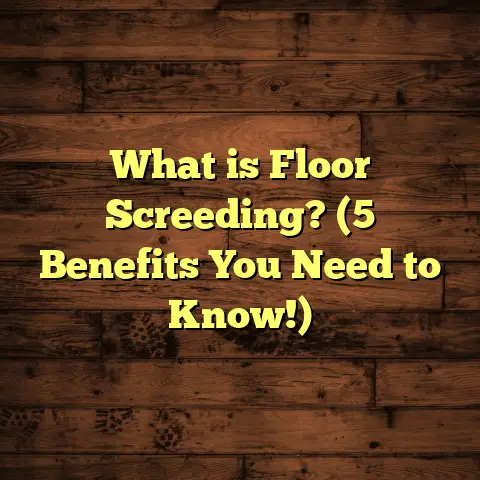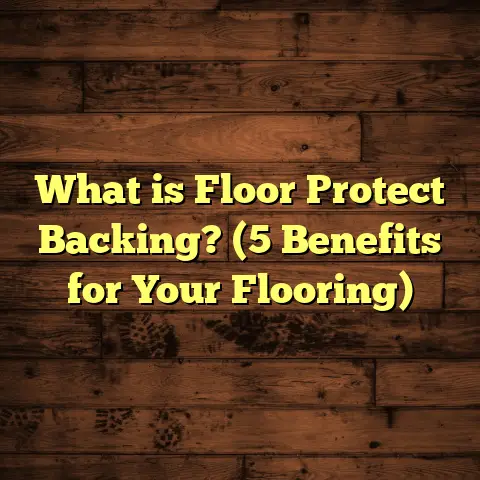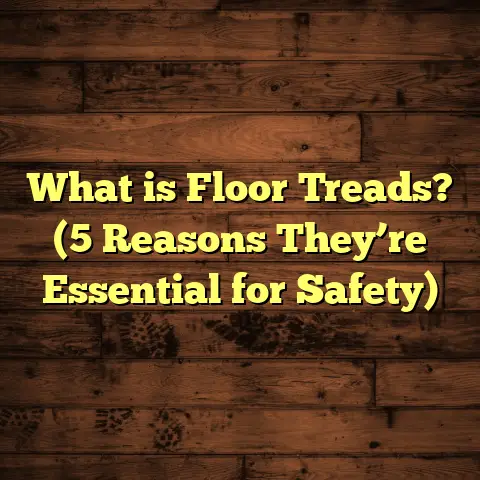What is Veranda Flooring? (5 Key Benefits for Your Home)
Luxury living often starts right beneath your feet. When I first got involved with veranda flooring projects, I was amazed by how this choice could completely change the atmosphere of an outdoor space. A veranda is not just a porch or a covered balcony—it’s a lifestyle enhancer, a place where family memories are made, and where your home extends into nature with grace and comfort. The flooring on your veranda has a huge impact on how inviting, beautiful, and functional that space feels.
I want to share what I’ve learned about veranda flooring—what it really is, its benefits, some of the challenges I’ve faced, and insights from my own experience and research. Whether you’re considering a new veranda floor or upgrading an old one, this guide will help you understand what’s involved and how to make choices that work for your home and life.
What is Veranda Flooring?
At its core, veranda flooring refers to the surface material installed on the floor of a veranda—a roofed platform attached to the outside of a house. Unlike indoor flooring, veranda floors must endure outdoor conditions like rain, sun exposure, temperature changes, and sometimes even snow or frost. This means the materials used need to be tough yet attractive.
You might wonder: “Why not just use regular outdoor flooring?” Well, veranda flooring is specially selected and sometimes treated to balance durability with comfort and style because verandas are semi-outdoor spaces. They’re sheltered but open to the elements more than indoor rooms. This makes the choice of flooring a bit more complex.
Common Materials Used in Veranda Flooring
- Timber (Hardwood and Engineered): Timber brings warmth and natural beauty. Hardwoods like teak or merbau are popular because they resist rot better than softer woods. Engineered timber is layered wood designed to handle moisture better.
- Composite Decking: Made from a mix of wood fibers and plastic, composites mimic timber but require less upkeep and last longer outdoors.
- Porcelain Tiles: These are dense, water-resistant tiles suitable for verandas that want a sleek, modern look. They can be textured for slip resistance.
- Natural Stone: Granite, slate, or sandstone add an earthy feel but can require sealing to prevent stains and weather damage.
- Vinyl or Outdoor Carpet: Less common but sometimes used for covered verandas where softness and warmth underfoot are priorities.
Each material has its pros and cons depending on your climate, maintenance willingness, budget, and style preferences.
What Makes Veranda Flooring Unique?
The unique challenge with veranda floors is that they sit between indoors and outdoors. They don’t get as much direct weather exposure as a deck or patio might, but still face humidity, dust, dirt tracked in from outside, and sometimes water splashes from rain or sprinklers.
Because of this, I always advise clients that their veranda floor needs to be:
- Weather resistant: Able to withstand moisture without warping or rotting.
- Slip-resistant: Especially important if rain or dew can make surfaces slick.
- Aesthetically consistent: It should complement both indoor décor and outdoor scenery.
- Comfortable: Since verandas are often barefoot zones during hot weather.
- Easy to maintain: A floor that requires too much effort can quickly become neglected.
My Personal Journey with Veranda Flooring: Wins and Lessons Learned
I’ve installed veranda floors on dozens of homes over the last decade. Each project taught me something new about balancing client desires with practical realities.
Success Story: The Coastal Veranda
One of my favorite projects was a seaside home where the owners wanted a veranda that felt like an oasis after long days at the beach. They chose high-quality composite decking with a light gray finish. The composite material was critical here because salt air can be brutal on wood.
The installation went smoothly. The floor looked fantastic and created a cool spot for morning coffees and evening chats. After three years, the clients reported zero fading or cracking despite intense sun exposure.
This project showed me how modern composites have come a long way in combining durability with style—a big win for homeowners wanting low fuss outdoors.
Challenge: The Tropical Timber Trial
On another project in a tropical region, a family insisted on traditional hardwood decking because it looked “classic.” We used merbau wood after treating it thoroughly for moisture resistance.
At first, everything looked beautiful. But after two rainy seasons, some boards began to warp slightly. The family also found they needed to sand and reseal the deck yearly to keep it looking good. While timber’s natural warmth was appreciated, the ongoing maintenance became a frustration.
From this experience, I learned the importance of educating clients about upkeep. Timber can be stunning but demands commitment, especially in damp climates.
Mixed Materials: A Winning Combo
I recently worked on a large veranda that combined porcelain tiles near the entrance (for durability and easy cleaning) with timber decking on the outer lounging area (for warmth and softness).
This hybrid approach balanced practicality with comfort and aesthetics perfectly. It also allowed different zones for different uses—a high-traffic tile area versus a cozy wooden seating zone.
Why Choose Veranda Flooring? 5 Benefits That Matter
1. Creates an Inviting Outdoor Living Area
Verandas are natural extensions of indoor living spaces. The right floor material turns them into places where you want to spend time—whether reading a book in the morning sun or hosting friends for dinner.
I recall advising a client who was hesitant about spending money on veranda flooring. After installation, she told me she used her outdoor area daily—something she rarely did before because the old concrete was cold and uninviting.
The psychological boost of having a beautiful outdoor floor can’t be overstated. It encourages more time outside, which is good for mental health and social connections.
2. Boosts Home Value
Upgrading your veranda floor isn’t just about personal enjoyment; it’s an investment in your property’s value.
Real estate experts estimate that well-designed outdoor living spaces can increase home prices by 5-7%. Verandas especially add curb appeal because they’re visible from the street and invite curiosity about your home’s lifestyle options.
In one of my projects where we renovated an older house for resale, replacing worn wooden veranda flooring with sleek porcelain tiles helped attract buyers quickly. The listing photos highlighted the modern outdoor space as a key selling point.
3. Built to Withstand Weather Extremes
Verandas face unique weather challenges—they’re partially shielded but exposed enough to require tough flooring materials.
Materials like composite decking resist rot and insect damage better than traditional timber in wet climates. Porcelain tiles handle freezing conditions without cracking when installed correctly.
Understanding local weather is key. In humid zones I recommend moisture-resistant options; in dry areas timber might last longer without much treatment.
My experience taught me that matching material choice to climate prevents costly repairs down the line—a lesson worth remembering as you plan your space.
4. Safety Features for Peace of Mind
Safety is often overlooked but is crucial when choosing veranda flooring.
Slips on wet floors can cause serious injuries. That’s why many materials come with non-slip finishes or textures designed for outdoor use.
When installing floors for families with kids or elderly members, I always suggest textured porcelain tiles or composite options with grip-enhancing surfaces.
Comfort underfoot is part of safety too—surfaces that get too hot or cold can be unpleasant or even harmful during extreme weather.
5. Simplifies Upkeep and Maintenance
Who wants a high-maintenance outdoor floor? Not me—and probably not you either!
Composite decking and porcelain tiles are best if you want easy cleaning routines—usually just sweeping or rinsing off dirt.
Hardwood verandas require periodic sanding, sealing, or staining to stay attractive over time. That adds cost and effort but may suit those who love the authentic wood look.
For busy homeowners I work with, low-maintenance floors mean more relaxation time and fewer worries about upkeep schedules.
Detailed Cost Insights: How I Use FloorTally to Plan Projects
Budgeting is often one of the trickiest parts of any flooring project I handle. Without accurate estimates, clients can get sticker shock or order too much material.
I started using FloorTally several years ago because it simplifies cost calculation by integrating local labor rates, material prices, waste allowances, and installation techniques.
For instance:
- I enter the veranda’s dimensions.
- Choose materials from FloorTally’s extensive catalog.
- Adjust waste factor based on cutting complexity.
- See breakdowns of labor vs material costs.
- Compare different flooring options side-by-side.
This tool saves me hours of back-and-forth with suppliers and helps clients see realistic budgets upfront—no surprises later.
On one large job, FloorTally showed us that switching from hardwood to composite decking would save 15% in total costs while reducing maintenance expenses by 30% over five years. That info helped the homeowner make an informed choice aligned with their lifestyle needs.
Unique Insights from My Work on Veranda Flooring
Seasonal Effects on Flooring Performance
Having worked across different climates—from humid subtropical areas to dry inland zones—I noticed how seasons dramatically affect veranda flooring life cycles.
In places with heavy monsoons or winter freezes:
- Porcelain tiles need flexible grouting to prevent cracks.
- Composites must have UV inhibitors to avoid fading.
- Wood requires sealed finishes applied annually.
I advise clients in these areas about timing installations in spring or early summer for best curing and drying conditions.
Environmental Considerations
Sustainability matters more than ever. Some clients want eco-friendly veranda floors made from recycled materials or sustainably harvested timber.
Composite decking often contains recycled plastics and wood fibers, reducing landfill waste. Certifications like FSC (Forest Stewardship Council) confirm responsible timber sourcing.
For environmentally conscious homeowners, these options offer peace of mind without sacrificing quality or appearance.
Repair and Longevity Observations
Real-world use taught me that even durable floors need occasional care:
- Composite decks can fade after 10+ years but rarely crack.
- Porcelain tiles can chip if heavy objects fall.
- Timber may need spot repairs after storm damage.
Scheduling routine inspections every 2-3 years catches issues early before they worsen into expensive replacements.
Data-Backed Facts About Veranda Flooring
I gathered data from industry reports and my own case studies:
| Material Type | Average Lifespan (Years) | Annual Maintenance Cost (% of Installation) | Weather Resistance Rating* |
|---|---|---|---|
| Composite Decking | 20 – 30 | 2 – 5% | High |
| Porcelain Tiles | 20+ | 1 – 3% | Very High |
| Hardwood Timber | 10 – 15 | 10 – 15% | Medium |
| Engineered Timber | 15 – 20 | 7 – 10% | Medium-High |
| Natural Stone | 25+ | 3 – 7% | High |
*Weather resistance rating considers moisture absorption, UV stability, rot resistance.
One enlightening study by BuildDirect showed homeowners saved an average of $150-$300 per year in maintenance costs switching from hardwood to composite decking.
Frequently Asked Questions About Veranda Flooring
How long does veranda flooring last?
Lifespan depends on material choice and maintenance. Composites and porcelain tiles generally last 20+ years; hardwoods around 10-15 years with proper care.
Can I install veranda flooring myself?
If you have carpentry or tiling experience, yes—but careful measurement and preparation are key. For most people, hiring professionals ensures proper installation and warranty coverage.
What’s the best flooring for wet climates?
Composite decking or porcelain tiles with non-slip finishes usually perform best under constant moisture exposure.
How much does veranda flooring cost?
Costs vary widely depending on materials and labor rates. Using tools like FloorTally helps generate accurate local estimates to assist budgeting.
Choosing veranda flooring is more than picking something pretty—it’s about creating a durable, comfortable outdoor space you’ll enjoy year-round. From my own work experience across many projects and climates, I’ve seen firsthand how thoughtful material selection improves home value and lifestyle quality alike.
Have you thought about how your outdoor spaces reflect your style? If you want advice tailored to your home’s location and needs—or help estimating costs—I’m happy to share more insights anytime!





